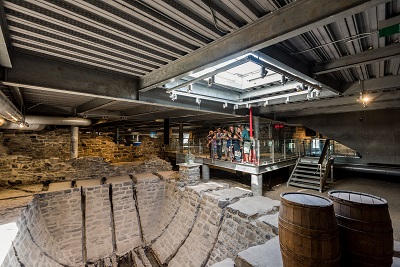Saint-Louis Forts and Châteaux National Historic Site of Canada
Québec, Quebec

Saint-Louis Forts and Châteaux NHSC
© Parcs Canada | Parks Canada
Address :
1 rue des Carrières, Québec, Quebec
Recognition Statute:
Historic Sites and Monuments Act (R.S.C., 1985, c. H-4)
Designation Date:
2002-07-18
Dates:
-
1620 to 1838
(Construction)
-
1620 to 1838
(Significant)
Event, Person, Organization:
-
Jean Bourdon
(Builder)
-
Major François Provost
(Builder)
-
Claude Baillif
(Builder)
-
Jean le Rouge
(Builder)
-
Hilaire Bernard de la Rivière
(Builder)
-
François de La Joue
(Builder)
-
Gaspard-Joseph Chaussegros de Léry
(Builder)
-
James Thompson
(Builder)
-
George Brown
(Builder)
-
John Marr
(Builder)
-
Wiliam Twiss
(Builder)
Other Name(s):
-
Saint-Louis Forts and Châteaux
(Designation Name)
-
Château Haldimand
(Other Name)
Research Report Number:
2001-030
Plaque(s)
Existing plaque: Saint-Louis Forts and Châteaux National Historic Site, Québec, Quebec
Beginning in the 17th century, a succession of forts and châteaux occupied this strategic site overlooking Québec's lower town and the St. Lawrence River. These structures, which survive today only as archaeological vestiges, were an integral part of the city's defence system. From 1620 to 1838, they were the centre of a "colonial court" at the heart of the political, social, and cultural life of the colony. The seat of executive power for over 200 years, this site also served as the official residence for 32 of the 40 French and British colonial governors.
Description of Historic Place
The Saint-Louis Forts and Châteaux National Historic Site of Canada is located on an escarpment overlooking the lower town of Old Québec. The site includes the archaeological remnants of major building campaigns between 1620 and 1838 including four Saint-Louis forts, two châteaux Saint-Louis and Château Haldimand as well as secondary buildings, landscapes and services such as courtyards, drains and military works. The archaeological site, in an area delineated by present Jardins des Gouverneurs, the Wolfe Battery, the present Château Frontenac Hotel and the associated Dufferin Terrace, is also part of the Fortifications of Québec National Historic Site of Canada. The designation refers to the ground within the designated place and its found remains.
Heritage Value
The Saint-Louis Forts and Châteaux was designated a national historic site of Canada in 2002 because an integral part of Québec’s defence system, this was the seat of colonial executive authority for over 200 years; they served as the official residences of 32 of the 40 Governors General from the colonial period.
The Saint-Louis Forts and Châteaux occupies a part of the most important location in colonial Quebec. It is an archaeological site with remnants of the buildings and structures that occupied it from 1620 to 1838: this includes Saint-Louis forts (1620, 1626, 1636, 1692), Châteaux Saint-Louis (1648, 1694) and Château Haldimand (1784). The heritage value of this site resides primarily in its historical associations as illustrated by its strategic location and the many layers of archaeological remains the site holds, each layer witnesses a distinct period of use, including that of both the French and English regimes. The footprints, forms, materials, technology, functional and spatial relationships of individual remnants provide essential evidence of historic activity.
Source: Historic Sites and Monuments Board of Canada, Minutes, 2001.
Character-Defining Elements
Key elements contributing to the heritage value of this site include: its dramatic and commanding position on a high promontory in Old Québec; the integrity and legibility of archaeological remains including the main traces of forts and chateaux, their support buildings and structures, related infrastructure and military constructs; associated found materials in their location, extent, form and spatial relationships to one another; remnants of the early gardens including plants and built forms, notably those related to the City’s fortification in colonial times; traces of the garden’s two components, le jardin des Gouverneurs, and the portion of the historic lower garden situated to the east of rue des Carrières with the footprints and spatial orientation of elements within and between these areas; features of the le jardin des Gouverneurs supporting its continued identity as an urban park namely its 40 tree varieties, 1753 three-sided garden wall remnant, small hexagonal kiosk, Wolfe and Montcalm obelisk, entrances and patterns of circulation; features distinguishing the lower garden, namely its lawn, long wooden Dufferin Terrace promenade, six 1878 kiosks, and use of Place d’Armes as a reference point defining circulation axes; continued association of knowledge acquired from objects excavated here with this site; the 360 degree viewscapes to the former Saint-Louis forts, the Saint Lawrence River, Lévis, and Île d’Orléans.